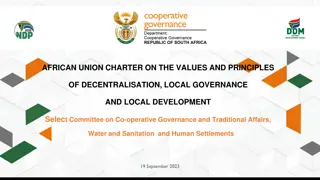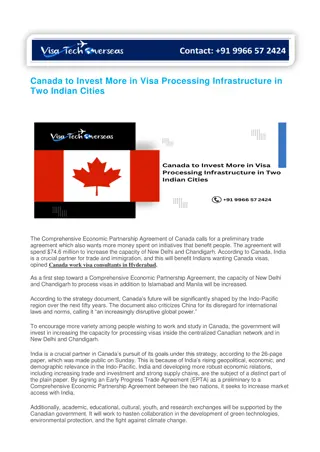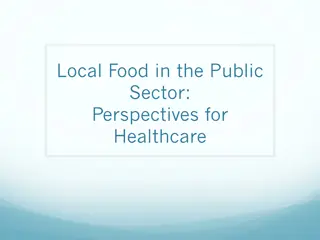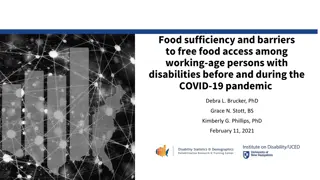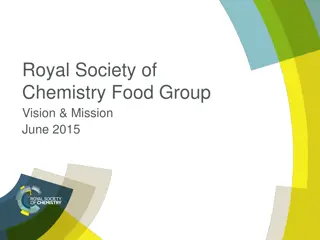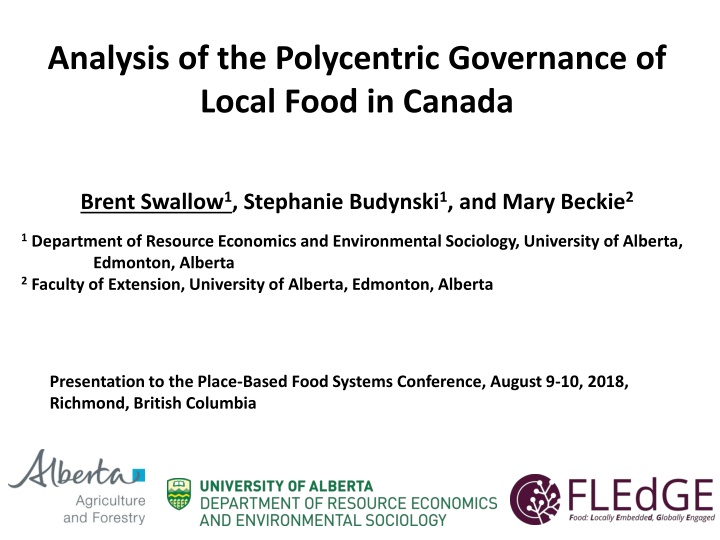
Polycentric Governance of Local Food in Canada
This analysis delves into the polycentric governance of local food in Canada, highlighting factors such as globalization, concentration in agri-food business, environmental concerns, and the increasing importance of local and place-based foods within the Canadian policy context. The study emphasizes the evolving role of municipalities and the benefits associated with local food systems.
Download Presentation

Please find below an Image/Link to download the presentation.
The content on the website is provided AS IS for your information and personal use only. It may not be sold, licensed, or shared on other websites without obtaining consent from the author. If you encounter any issues during the download, it is possible that the publisher has removed the file from their server.
You are allowed to download the files provided on this website for personal or commercial use, subject to the condition that they are used lawfully. All files are the property of their respective owners.
The content on the website is provided AS IS for your information and personal use only. It may not be sold, licensed, or shared on other websites without obtaining consent from the author.
E N D
Presentation Transcript
Analysis of the Polycentric Governance of Local Food in Canada Brent Swallow1, Stephanie Budynski1, and Mary Beckie2 1 Department of Resource Economics and Environmental Sociology, University of Alberta, Edmonton, Alberta 2 Faculty of Extension, University of Alberta, Edmonton, Alberta Presentation to the Place-Based Food Systems Conference, August 9-10, 2018, Richmond, British Columbia
Globalization Concentration in agri-food business Global finance ownership Obesity & diet-related health problems Environmental burden of production Distancing between producers and consumers International agreements, national policies, international competitiveness Source: Jennifer Clapp, 2018. Introduction (1/4)
Globalization Concentration in agri-food business Global finance ownership Obesity & diet-related health Environmental burden of production Distancing between producers and consumers Localization Local food perceived to have multiple benefits Place-based foods perceived to be more authentic Local governments more involved, multiple objectives (eg. Milan Urban Food Pact; Edmonton s Fresh Strategy) International agreements, national policies, international competitiveness Introduction (2/4)
Canadian Policy Context Heavy dependence on agricultural exports and food imports Concentration of agri-food business & land ownership (e.g Sobey s / Safeway; Nutrien) Decline of food processing sector Vulnerability to US, greater importance of bilateral trade agreements Constitution indicates agriculture as a shared federal / provincial responsibility Increasing interest in local and placed-based foods and increasing role of municipalities Introduction (3/4)
Objectives 1. Articulate and apply a poly-centric governance approach to analysis of food policy 2. Summarize results of first analysis for Canada Introduction (4/4)
Value Chain Framework Poly-centric governance approach (1/3)
Overlapping levels of influence International National Provincial Municipal Poly-centric governance approach (2/3)
Qualitative public policy analysis 1. Identify problem context (policy determinants of local and place-based foods). 2. Identify relevant levels of public policy & governance (municipal, provincial, federal). 3. Identify public policy objectives at each level. 4. Purposively select and analyze cases for a range of specific local contexts. 5. Summarize and analyze policies in case studies, emphasis on contradictions, contrasts, gaps. 6. Generalize results Breitkreuz, R., Stanton, C. J., Brady, N., Pattison Williams, J., King, E. D., Mishra, C., & Swallow, B. (2017). The Mahatma Gandhi National Rural Employment Guarantee Scheme: A Policy Solution to Rural Poverty in India? Development Policy Review 35(3): 397-417. Poly-centric governance approach (3/3)
Table 1: 11 Objectives for Canadas agri-food system Policy objective Strengthening food security and affordability for vulnerable populations 2 Encouraging healthy eating and good nutrition 3 Ensuring safe food and public trust in the food system 4 Protecting Canadian consumer markets for supply by Canadian producers 5 Increasing profitability and competitiveness of food producers & processors 6 Promoting sale into international export markets Justification / Inspiration UN Rappateur Report; House of Commons Standing Committee Report; Urban Food Charters 1 Nordic Food Policy; Health Canada s Healthy Food Strategy; Urban Food Charters Safe Food for Canadians Act (2015); food fraud, traceability, and certification regulations; animal welfare issues in the House of Commons Standing Committee Report. Supply Management System for dairy, poultry, eggs; Fed- Prov Business Risk Management Programs; Barton Reports; New farm and food business development programs; Canadian Agricultural Partnership Multi-lateral and bilateral trade agreements; Baron reports. Incubators for new food products . Barton reports. 7 8 Enhancing innovation Maintaining healthy landscapes, reducing environmental impact Sustaining and protecting land and natural resources Wetland conservation programs; pesticide regulations; support for beneficial management practices Farmland preservation trusts and policies; municipal zoning regulations; urban food charters 9 Urban food charters; procurement policies of MASH Institutions (municipalities, academic institutions, school boards, healthcare providers); Senate Report on how to keep farmland in the hands of Canadian farmers. Encouraging a vibrant local food system, culture and rural societies 10 Nordic Food Policy; urban food charters 11 Reducing food waste Results (1/6)
Areas of conflict between policy objectives Supply management system for poultry, eggs, dairy protects Canadian market for medium-large scale producers and processors -- tradeoffs with food affordability; specialized production for local markets; competitiveness in international markets Restrictions on inter-provincial trade to protect local markets Eg. Differential provincial support for craft beer Local food safety standards for local sales at farmers markets Supports small to medium scale, may limit larger scale and exports Results (2/6)
Areas needing policy harmonization Provincial innovation funds are small and diffuse. Local priorities limit national cohesion in many fields of innovation (eg Barton / McKinsey reports) Protein Industries Supercluster, using plant genomics and novel processing technology to increase value of key Canadian crops, including canola, wheat and pulses Results (3/6)
Areas of contrast between jurisdictions Farmland preservation (BC ALR, Ontario Greenbelt, Nova Scotia community easements; devolved to municipalities in Alberta) Support for small & medium scale processors focused on local markets (innovation, start-up, compliance with food safety regulations) Urban agriculture as a policy problem or opportunity (contrast in policy attention among Alberta municipalities) Promotion of local food cultures Food sourcing by MASH organizations (municipalities, academic organizations, schools, hospitals) Results (4/6)
Areas of Policy Gap Healthy eating and diet-related disease management (especially compared to the Nordic policy environment) The never-ending war for Canada s Food Guide (MacLean s, It s been 10 years since the last revision, and it took two years and 20,000 submissions to overhaul it. And almost nobody will agree with the result. by Murad Hemmadi Apr 9, 2018 Food waste No national policy, mostly addressed by municipal governments Comprehensive national food policy (in progress) Results (5/6)
Areas of Policy Gap Food security and food rights UN Rapporteur on the right to food First Nations and coordinating federal and provincial responses NGOs and food corporations filling much of the gap through food banks No national food policy Results (6/6)
Conclusions 1. Qualitative policy approach as a complement to quantitative and indepth studies 2. Canadian policy approach is fragmented, with numerous gaps and contradictions. 3. Policy advocacy tends to be either / or 4. Possibility of a Nordic approach? Supported by leaders at multiple levels Led by nutrition & food security objectives Stressing constructive consultation, public-private-NGO partnerships Acknowledging advantages of specific policy tools Conclusions (1/1)


